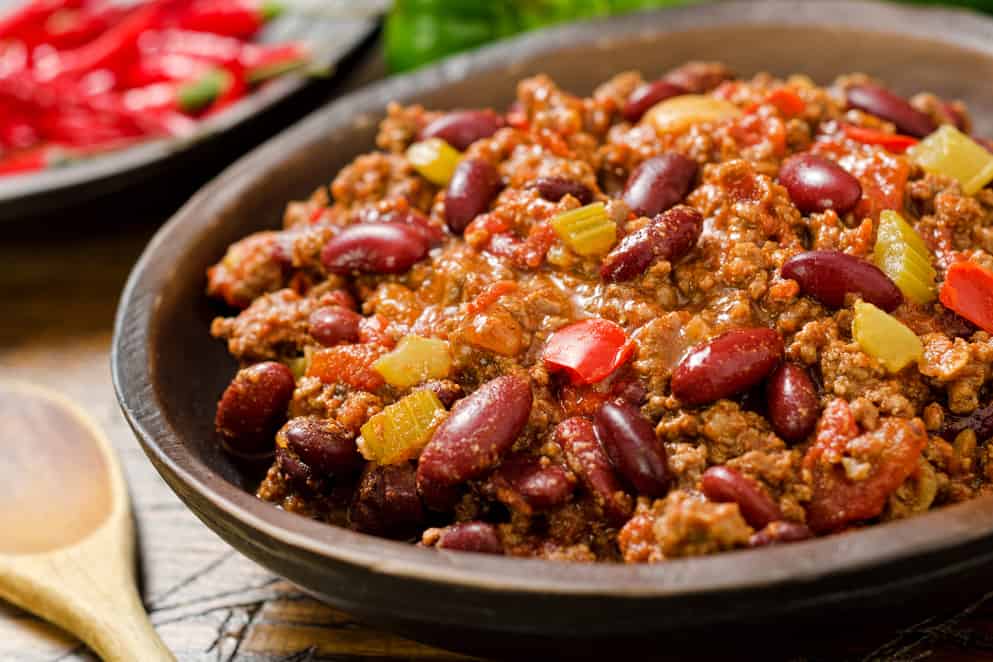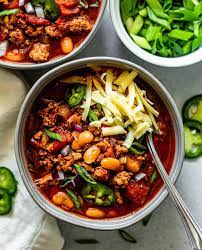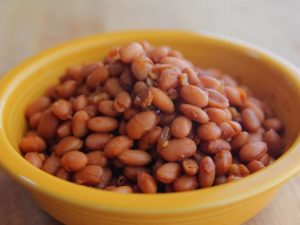
The short answer: Yes, if you do it right. Chili is one of the most popular stews in America. It is relatively easy to make, and it requires a minimum of kitchen skills. In other words – it’s Bachelor Food!
There’s nothing wrong with canned chili. That’s a good item to have in your pantry for quick meals on busy days. But, chili is a dish almost any inexperienced cook can make from scratch. Plus, chili is very customizable to your particular taste. There are thousands of chili recipes out there. It freezes well, so it’s good to make a big batch so you have plenty of good meals. Chili can be served at any meal. It can be the center of the meal or a side dish.
The origin of this dish is lost in the mists of history. The earliest reference found comes from 1529 in the writing of a Spanish monk describing an Aztec chili-flavored sauce in a stew. We most associate chili with America’s Old West in the Southwestern states. People in Texas claim the birth of chili but insist real chili is meat, flavored with chili pepper and other spices. But most of us see chili as a stew of meat, beans, tomatoes, cayenne pepper and cumin.
But Is It Healthy?
Believe it or not, chili has lots of nutritional benefits. Meat provides protein, beans give you protein and fiber, tomatoes give you lots of good antioxidants and other good things. You can make your favorite recipe a little healthier with a few tweaks.

The main ingredient that makes it chili is the use of chili peppers to give the dish a flavorful kick. Researchers have found capsaicin, the “hot” factor, is a powerful anti-inflammatory agent. Also, hot peppers contain antioxidant, anti-cancer, and anti-diabetes effects. Not only that, another research study from the American Heart Association showed that people who regularly eat chili peppers generally live longer. The study found that regular hot pepper eaters have a 25% reduction in death from any cause, a 23% reduction in cancer deaths, and a 26% reduction in deaths from heart disease. Other studies have shown that chili peppers may also help control your appetite and boost your metabolism, causing you to burn more calories. Yes, you could lose weight by eating chili. Scientists say the best way to get those benefits is to spice up your food. Capsaicin turns on hormones that suppress appetite and shuts off hormones that stimulate appetite. Just a quarter teaspoon of ground chili pepper in your food is enough, but higher amounts produce more health effects.

The Ticklish Topic Of Tomatoes
The original Aztec chili did not contain tomatoes. Those got added as chili spread from Texas and Northern Mexico in the 18th century. And it’s a good thing because tomatoes contain a very powerful antioxidant called lycopene. This potent flavonoid gives tomatoes their red color and has been found to reduce the risk of some cancers, diabetes, heart disease and memory loss. What’s more, you want those tomatoes cooked rather than raw. The lycopene in the fruit is released from the flesh under heat. Also, it changes shape when cooked making it easier for your body to absorb and process. Research shows up to 170% more lycopene in cooked tomatoes over raw.
In The Bachelor’s Kitchen, we are big fans of canned tomatoes, which have just as much nutrition as fresh-then-cooked. Tomato season lasts about two months in the late summer and early fall, depending on where you live. The rest of the time, we feel canned is best. Those tomatoes are picked and processed at their peak. Because they are cooked in the canning process, they are full of lycopene. But check your labels. Try to find tomatoes with low salt and juice rather than puree. We like to buy whole, peeled tomatoes and break them down ourselves as opposed to a can of diced tomatoes, which are treated with a preservative to help them from becoming mushy.
Bring On The Beans
This is probably the most controversial element of chili. Some versions say no to added beans in the stew. Others cook the beans separately and pour the chili over them. Some add a layer of pasta or a couple of eggs or rice underneath the sauce and beans. Beans are most likely an addition made during the country’s westward expansion. Dried beans travel well and would likely have been found served along side or within the chili.
But if you want a healthy dish, you want to include the beans. One cup of beans adds about 15 grams of protein, and 15 grams of fiber, plus potassium, folate and other nutrients. Beans have been shown to help the risk of heart disease and high blood pressure.
Veg It Up
Chili purists might scoff at this element, but chili, in almost any variation, is ideal for adding lots of veggies to up the nutritional content, making it a whole meal in a bowl. Adding more vegetables to your chili will add antioxidants, fiber and other nutrients without increasing calories. Yes, that means you could lose weight eating chili. Dieticians suggest adding some shredded carrots, chopped bell peppers, cubed sweet potatoes or winter squash to the pot. Also, the extra veggies will help balance out the spices in your chili.
Use Less Meat

Meat is the best source of protein, but it’s also the least healthy ingredient because it contains so much fat. And yet, that fat is part of the flavor. There are some really great vegetarian chili recipes out there. Mushrooms can add a meaty texture and flavor without the saturated fat and calories. But if you don’t want to give up the meat, you can choose leaner meats. For example, you could buy lean ground beef with lower fat content. Also, no matter what meat you use, drain it after browning and adding it to the pot. Ground chicken and turkey also contain a lot less fat than regular ground beef.
You can even replace some or all of the meat with tofu or whole grains like bulgar wheat or farro. Nutritionists say the grains swell during cooking giving the chili a slightly chewy texture and body. You can even add something like wheat germ to your regular chili recipe to add fiber, protein and important minerals.
Super Up Your Sides And Toppings
Obviously, what your serve with your chili can add or detract from the healthiness of your “bowl of red.” White rice is a popular accompaniment to chili. But you could also use brown rice, quinoa, or farro. And do you really need that dollop of sour cream? How about a dollop of plain Greek yogurt instead? You can also top your bowl with sliced avocado, chopped onions, scallions, fresh herbs or broken taco shells. If you serve your chili with a tortilla on the side, opt for corn rather than wheat flour, it has less than half the fat and calories.
Make Your Own Chili Now
We have a recipe we like here on The Bachelor’s Kitchen Blog. It uses some prepared ingredients which cut the cooking time and make it even easier. But all chili recipes have in common the basic formulas of meat, tomatoes, beans, and spices. Whatever chili you make, remember that as good as it is right after it’s cooked, it will taste even better the next day after the flavors have had a chance to meld.






